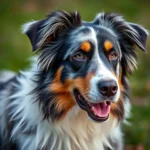
Introduction
Dog breeds play a significant role in our lives, providing companionship, protection, and even assistance in various tasks. One breed that stands out for its unique characteristics is the Westphalian Dachsbracke. This breed, with its fascinating history and remarkable traits, deserves a closer look. Understanding specific dog breeds is essential for potential owners to ensure they choose the right companion suited to their lifestyle and preferences.
History of the Westphalian Dachsbracke
Origin
The Westphalian Dachsbracke hails from the Westphalia region of Germany, a place renowned for its rich hunting traditions. This breed was developed in the late 19th century, primarily to serve as a versatile hunting dog. Breeders focused on creating a dog that could adeptly track various game, including deer and wild boar, showcasing its adaptability and keen sense of smell.
Purpose and Function
Traditionally, the Westphalian Dachsbracke was bred for hunting. Its ability to track scents and navigate through dense underbrush made it invaluable to hunters in the region. The breed’s unique physical characteristics allowed it to thrive in various terrains, whether in forests or open fields. This adaptability not only highlights the breed’s capabilities but also underscores its historical significance in the hunting community.
Physical Characteristics
Size and Weight
The Westphalian Dachsbracke typically stands between 13 to 15 inches tall and weighs around 30 to 40 pounds. This size makes it smaller than many hunting breeds but not as diminutive as others. When compared to similar breeds, such as the Dachshund or the Beagle, the Westphalian Dachsbracke is more robust, with a sturdier build that reflects its working background.
Coat and Color
The coat of the Westphalian Dachsbracke is short, dense, and weather-resistant, providing protection during hunting expeditions. Common color patterns include a mix of black, brown, and tan, often with distinct markings that enhance their attractiveness. These coat characteristics not only serve a functional purpose but also contribute to the breed’s overall aesthetic appeal.
Distinctive Features
One of the most notable physical traits of the Westphalian Dachsbracke is its long, droopy ears, which enhance its tracking abilities by capturing scents from the ground. The breed also has a powerful, muscular body, a slightly elongated shape, and a tail that is typically carried high, reflecting its alert demeanor. Overall, the Westphalian Dachsbracke is a striking breed, exuding both strength and grace.
Temperament and Behavior
General Temperament
The Westphalian Dachsbracke is known for its friendly and intelligent nature. These dogs are eager to please, making them excellent companions for families. They tend to get along well with children, showcasing a gentle disposition that makes them suitable for households with young ones. Their loyalty and affectionate behavior further solidify their place as cherished family pets.
Socialization Needs
Early socialization is crucial for the Westphalian Dachsbracke. Exposure to various environments, people, and other animals from a young age helps cultivate a well-rounded and confident adult dog. Best practices for introducing them to new experiences include positive reinforcement and gradual exposure, ensuring that they feel comfortable and secure in diverse situations.
Training and Intelligence
The Westphalian Dachsbracke is a highly trainable breed, thanks to its intelligence and eagerness to learn. Effective training methods include positive reinforcement, consistency, and patience. It’s essential to establish clear commands and boundaries early on to prevent any behavioral issues from developing. Common challenges may include stubbornness, which can be managed through engaging training sessions that stimulate their minds.
Care Requirements
Exercise Needs
Maintaining a healthy lifestyle is vital for the Westphalian Dachsbracke. These dogs require a moderate amount of exercise, ideally around 60 minutes per day. Suitable activities include daily walks, play sessions in a secure yard, and engaging in interactive games. Physical activity not only keeps them fit but also helps channel their energy positively, reducing the likelihood of behavioral problems.
Grooming
Grooming the Westphalian Dachsbracke is relatively simple due to its short coat. Regular brushing, typically once a week, is sufficient to remove loose hairs and maintain a healthy coat. Special attention should be given to their ears, as regular cleaning can prevent infections, especially given their droopy ear structure. Overall, grooming is manageable and does not require extensive time or specialized knowledge.
Health Considerations
Like all breeds, the Westphalian Dachsbracke is prone to certain health issues. Common concerns include hip dysplasia, ear infections, and obesity. Regular veterinary check-ups are crucial for early detection and management of potential health problems. Preventative care, such as a balanced diet and routine exercise, plays a significant role in maintaining the breed’s overall health.
Living with a Westphalian Dachsbracke
Ideal Living Conditions
The Westphalian Dachsbracke thrives in various living conditions, but it is essential to provide ample space for them to move around. They adapt well to both urban and rural environments, although access to outdoor space is a significant advantage. A securely fenced yard is ideal for allowing them to play and explore safely.
Compatibility with Other Pets
Generally, the Westphalian Dachsbracke is sociable and can coexist peacefully with other pets, especially if socialized from a young age. However, their hunting instincts may lead them to chase smaller animals. Tips for multi-pet households include gradual introductions and supervised playtime to ensure that all pets feel comfortable and safe.
Lifespan and Aging
The average lifespan of the Westphalian Dachsbracke ranges from 12 to 14 years, which is relatively typical for medium-sized breeds. As they age, senior care considerations become increasingly important. Regular veterinary check-ups, a balanced diet tailored to their age, and gentle exercise can help maintain their quality of life as they transition into their golden years.
Adoption and Breeding
Finding a Westphalian Dachsbracke
For those interested in adding a Westphalian Dachsbracke to their family, there are various options for adoption or purchase. Reputable breeders and breed-specific rescue organizations are excellent places to start. Key questions to ask potential breeders include inquiries about health testing, socialization practices, and the overall temperament of their dogs.
Responsible Breeding Practices
Ethical breeding practices are essential for the health and well-being of the Westphalian Dachsbracke. Responsible breeders prioritize health testing, genetic screenings, and proper socialization. They should be transparent about their breeding practices and be willing to provide references from previous puppy owners. Potential owners should look for breeders who genuinely care for the breed and its future.
Conclusion
The Westphalian Dachsbracke is a remarkable breed with unique traits and care needs. Their friendly nature, adaptability, and intelligence make them outstanding companions for families and individuals alike. For potential owners, understanding the specific requirements of this breed is crucial to providing a loving and supportive environment. Owning a Westphalian Dachsbracke can bring immense joy and fulfillment, enriching your life with loyalty and affection. Consider welcoming one of these wonderful dogs into your home; their presence can truly make a difference.
Feel free to share your experiences with the Westphalian Dachsbracke or ask any questions you might have about this incredible breed!









